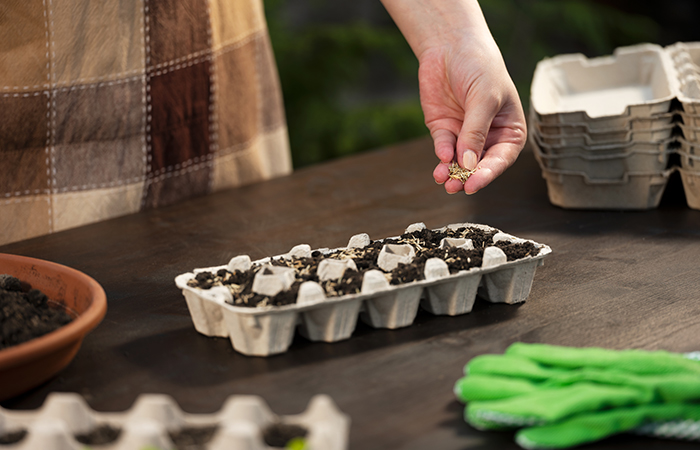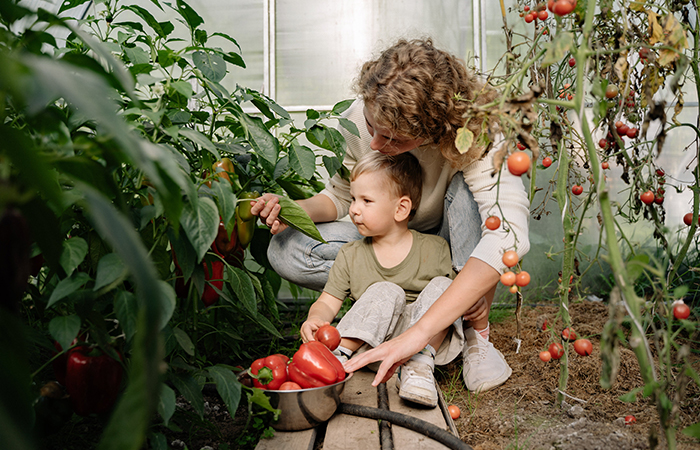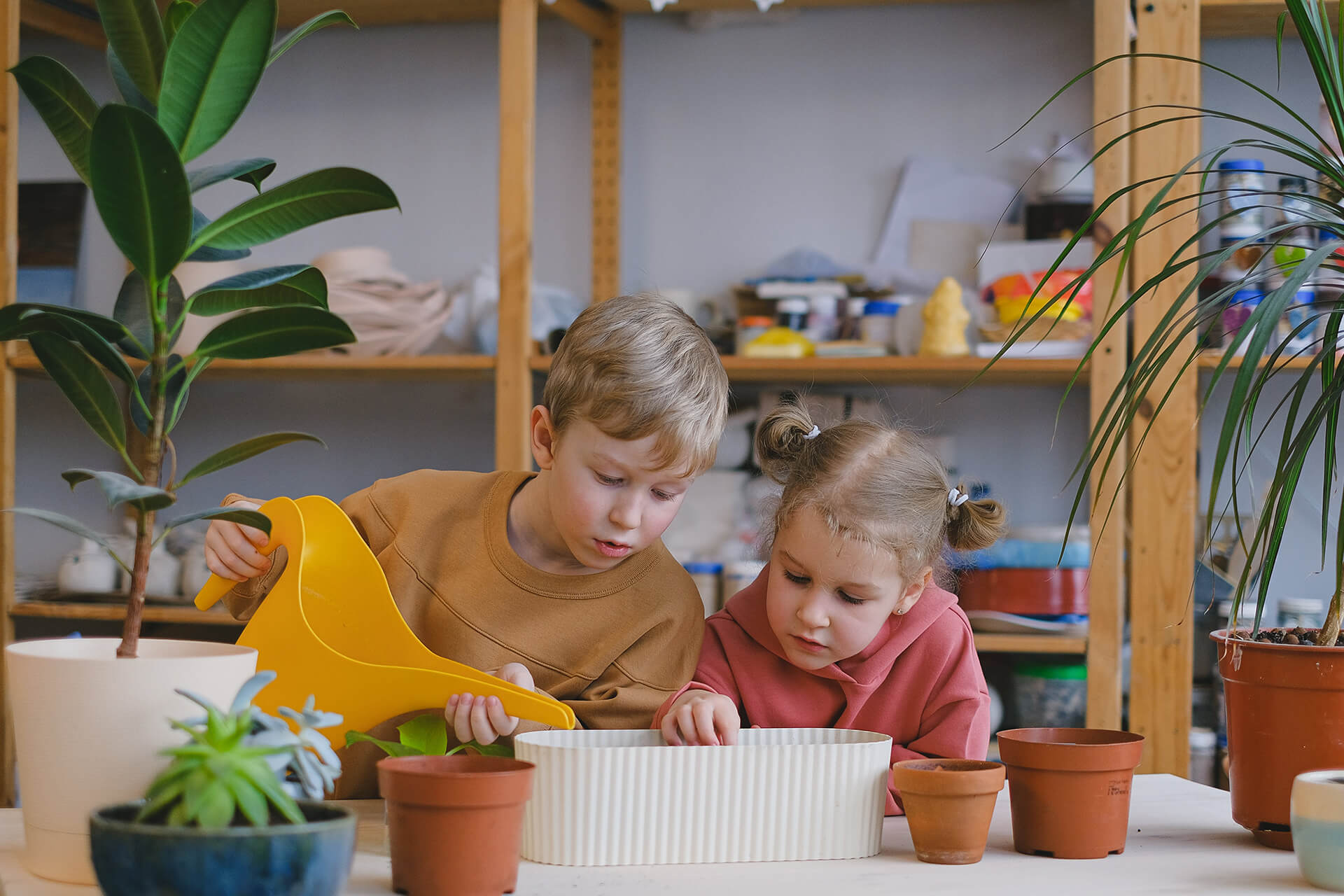La huerta: un mundo de diversión para aprender sobre los alimentos
¿Buscas una actividad para niños que sea educativa y que fomente la confianza en sí mismos? Te sugerimos probar con la huerta.
La mayoría de nosotros recuerda haber cultivado habas en un vaso de papel en la escuela primaria y la emoción de verlas crecer. Puedes ofrecerles a tus hijos la misma alegría y enseñarles de dónde provienen los alimentos creando tu propia huerta. Incluso esto puede hacer que ellos se interesen por comer y cocinar vegetales. Y esta es una verdadera conquista. No te preocupes si no tienes un jardín ni mucho espacio: también puedes cultivar en el porche o en el patio.
¿Sabías qué?
El trabajo en la huerta puede enseñarle a tu hijo sobre matemáticas, ciencias y la naturaleza. También es un hábito saludable, porque pasar tiempo al aire libre reduce el ritmo cardíaco y la tensión muscular, y la exposición al sol aumenta los niveles de vitamina D. El trabajo en la huerta puede incluso beneficiar al sistema inmunitario.
Preparados
- Piensa dónde vas a empezar tu huerta y qué tipo de huerta quieres. Además de vegetales, también puedes plantar hierbas o flores. Incluso puedes cultivar un “jardín de salsa”. Los chiles y los tomates crecen muy bien en verano, incluso en un recipiente. Cualquier espacio servirá, siempre que le dé el sol.
- Descubre tu “zona de rusticidad para plantas”, que te ayudará a saber qué plantas crecen mejor en tu zona. Ingresa al sitio web del Departamento de Agricultura de los Estados Unidos (USDA) aquí y escribe tu código postal para encontrar tu zona.
- Observa tu espacio y determina cuántas horas de sol recibe tu huerta o patio, y luego elige una planta cuyas necesidades de sol coincidan con estas condiciones.
- Piensa en cultivar plantas autóctonas, que se adapten al clima y al suelo locales. Algunas plantas autóctonas que florecen atraen a los colibríes, mientras que otras atraen a las mariposas, que son una belleza para la vista. Las plantas autóctonas no requieren abono y necesitan menos agua. Encuentra plantas para la huerta y listas de plantas autóctonas gratis aquí.
- Consulta a un experto qué crece mejor en tu zona. Puede ser alguien de un vivero local o de una tienda de mejoras para el hogar, o un representante de la oficina de extensión del condado de tu ciudad. Encuentra la oficina de extensión del condado aquí.
CONSEJO
Obtén aún más beneficios de frutas y vegetales con el Programa Especial de Nutrición Suplementaria para Mujeres, Bebés y Niños (WIC). Guarda semillas de tomates, pimientos, habas y guisantes, y úsalas para empezar a cultivar tu propia huerta.
Listos
- La forma más económica, y a menudo la mejor, de empezar una huerta es plantar semillas. Si quieres empezar antes de la primavera (o el invierno), puedes utilizar maples de huevos para plantar las semillas en el interior. Una vez que estas broten, se pueden cortar las secciones y se puede poner toda la sección de cartón en la tierra.
- Incluye a tus hijos en la planificación consultando libros sobre huertas de la biblioteca o fotos en Internet. (Encuentre una lista de libros sobre huertas para niños aquí.) Es divertido ir a un vivero a ver las plantas y oler las distintas hierbas antes de elegir cuál plantar.
- No es necesario tener macetas sofisticadas: puedes plantar las semillas en envases de yogur desechados o incluso en contenedores de plástico. Solo debes hacerles agujeros en la base de los recipientes para que drene el agua.


¡Ya! Hagamos la huerta
- Deja que tu hijo remueva la tierra para que se acostumbre a trabajar con ella. Busca herramientas pequeñas y fáciles de usar para tu hijo. Las cucharas y los tenedores de bebé pueden servir para los niños de manos pequeñas.
- En los paquetes de semillas se indica la profundidad a la que estas deben plantarse. Marca los palos de madera para manualidades en pulgadas para poder plantar las semillas al nivel adecuado.
- Elabora un cronograma de riego y desmalezado para ti y tu hijo. Algunas plantas requieren que se eliminen las flores muertas para que otras puedan crecer. Un cronograma le enseña a tu hijo responsabilidad y es un buen recordatorio para regar, sobre todo cuando las semillas aún no han germinado.
- Aprende y enseña a tu hijo cuándo es el mejor momento para recoger un tomate o cómo se debe cortar una flor o una hierba, por ejemplo. Háblale de cómo van a utilizar lo que cosechen: ¿se comerán los tomates cherry de la parra o los cortarán en rodajas para un sándwich? ¿Pondrán la flor en un jarrón o se la darán a la abuela?
- Evita utilizar productos químicos en la huerta, ya que no son necesarios y su uso puede ser peligroso cerca de los niños.
- Al final del ciclo de cultivo, deja que las flores se marchiten y recoge las semillas para plantarlas el próximo año. Considera la posibilidad de trasplantar las plantas de hierbas en una maceta para mantenerlas en el interior durante el invierno.
